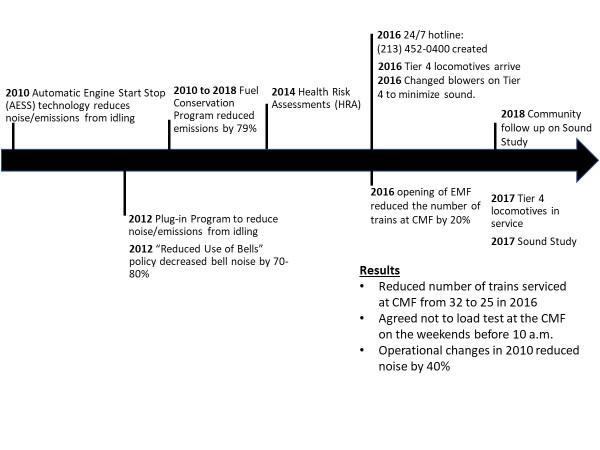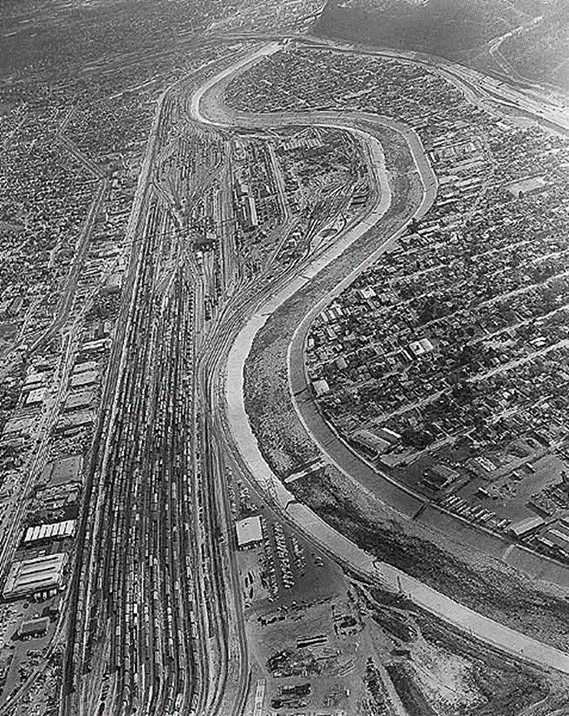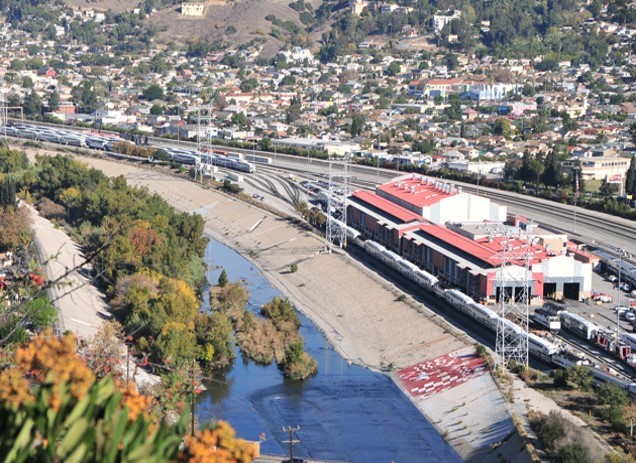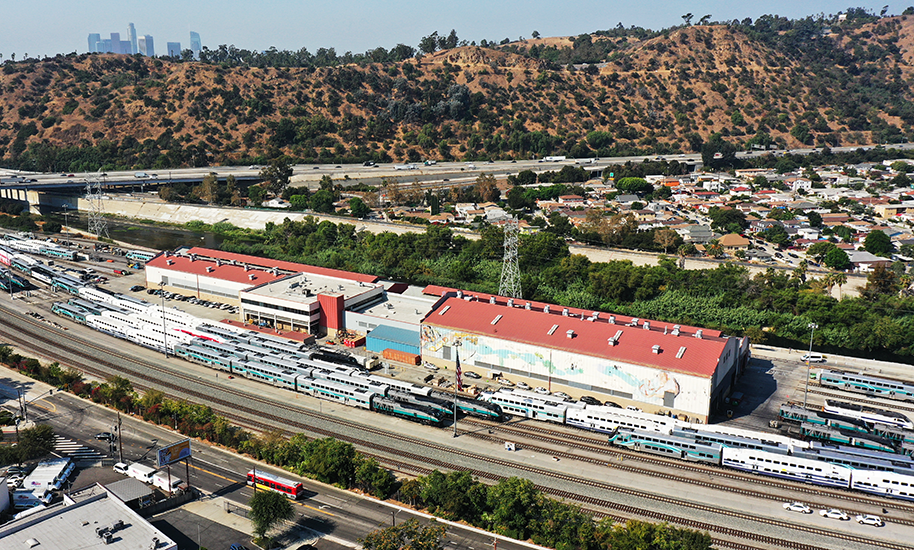Central Maintenance Facility (CMF)
The property where Metrolink’s Central Maintenance Facility (CMF) is located, previously known as Taylor Yard, serviced locomotives and rail cars since the 1920s. Metrolink operates 365 days a year. The Central Maintenance Facility (CMF) provides a critical function for Metrolink to provide this regional service. CMF is one of two service, inspection and repair facilities in the Metrolink system and the only facility equipped to handle heavy maintenance and repair. Following early morning peak runs, nearly all Metrolink trains arrive at CMF to be inspected, tested, fueled, cleaned and serviced for afternoon departures. Metrolink is committed to meeting the transportation needs of the region in the safest and cleanest way possible, while being a good neighbor to the surrounding communities.
Operations Overview
CMF is one of two service, inspection and repair facilities in the Metrolink system and the only facility equipped to handle heavy maintenance and repair. Following early morning peak runs, nearly all Metrolink trains arrive at CMF to be inspected, tested, fueled, cleaned and serviced for afternoon departures. Testing usually takes between 45-60 minutes, but may take longer depending on equipment arriving for service, as any defects needing to be addressed prior to departure are corrected. During the inspection and testing process, the locomotives are required to be running to perform various functional tests mandated by the Code of Federal Regulations 49 Parts 200-299. More details about our operations can be found in the CMF factsheet:
CMF DIAGRAM KEY
- Locomotive Fueling Area – Trains are refueled for departure.
- Standby Generator – A backup generator is located in the northern half of CMF to supply emergency power.
- Fuel Truck Parking – The fuel truck, although not used at CMF, is stored to be used off site or in case of emergency.
- S&I Tracks – Daily Service and Inspection (S&I) takes place here. These tasks include required safety system testing and inspections along with cleaning, fueling, troubleshooting and repairs. Troubleshoot may include load testing.
- Load Testing – Periodic locomotive and HEP engine load testing.
- Locomotive Shop – Heavy machine maintenance and repair takes place here.
- Standby Generator – A backup generator is located in the southern half of CMF to supply emergency power.
- Ground Power Stations – Ground power stations available for wayside electrical power.
- River Tracks – All trains enter CMF from the south via these tracks paralleling the LA River.
- Storage Tracks – Daily Service and Inspection (S&I) takes place here. These tasks include required safety system testing and inspections along with cleaning, troubleshooting and repairs. Troubleshoot may include load testing.
Description: For the last two years we have been working to improve our relationship with the CMF community. Recognizing that noise is a community concern, Metrolink decided to place Permanent Sound Monitors in both the community and at the facility to allow transparency. Two monitors have been placed in the community with the access to the live data provided at our website and two installed in the yard for comparison, a total of four monitors.
Disclaimer: Street noise such as trash trucks, ambulances or tree trimmers can impact the sound monitor readings. The monitors at the CMF will serve to measure noise at the yard and will be compared to the community readings.
Note: The dB(A) is a unit of measurement for noise that is perceived by the human ear. The dB(A) is used by The City of Los Angeles to determine compliance to noise standards and is the A-weighting of the standard sound level that is measured in decibels (dB).
Train movement and switching occur throughout the CMF.
Private properties (residential and business) are located away from the CMF as follows:
- East side: 160 ft. to 650 ft.
- West side: 395 ft. to 464 f
*As of December 31, 2019
Sand Towers
CMF has two sand towers which are used to store and distribute sand to locomotives as needed. Sand is used to provide traction and prevent wheel slip when moving locomotives. We receive sand deliveries up to 6 times a year.

Sand Towers, circled in orange, at the CMF.
This video gives and overview of the sand delivery process and how our Sand Towers are used at the CMF.
Upgrading Our Fleet-Tier 4 Locomotives
Metrolink is transitioning primarily to a fleet of Tier 4 locomotives, with 40 units ordered. The state-of-the-art Tier 4 locomotives are the cleanest diesel locomotives in the nation, providing wide-ranging environmental benefits for our region. We anticipate all 40 units will be in service by summer 2020.
More information on Tier 4 locomotives can be found HERE: metrolinktrains.com/tier4.
Continuous Improvements
Metrolink has a long history with the CMF community -- including residents, businesses, elected officials and other stakeholders in Cypress Park, Glassell Park and Elysian Valley. In the past eight years, Metrolink has made various operational enhancements and modifications to reduce negative impacts to the community including, but not limited to:

UPCOMING MEETINGS
Get face-to-face with Metrolink.
VIRTUAL MEETINGS:
The Central Maintenance Facility
Virtual Meeting Room will open on
NO MEETINGS ARE SCHEDULED AT THIS TIME
BOARD MEETINGS:
If you would like to attend a Board of Directors meeting that information can be found at: metrolinktrains.com/about/board-meetings/
COMMUNITY MEETINGS:
![]() CMF Action Plan January 2022 Update
CMF Action Plan January 2022 Update
![]() CMF Action Plan September 2021 Update
CMF Action Plan September 2021 Update
![]() CMF Action Plan August 2021 Update
CMF Action Plan August 2021 Update
![]() CMF Action Plan July 2021 Update
CMF Action Plan July 2021 Update![]() CMF Action Plan June 2021 Update
CMF Action Plan June 2021 Update![]() CMF Action Plan May 2021 Update
CMF Action Plan May 2021 Update ![]() CMF Action Plan April 2021 Update
CMF Action Plan April 2021 Update![]() CMF Action Plan-March 2021 Update
CMF Action Plan-March 2021 Update![]() CMF Action Plan February 2021 Update
CMF Action Plan February 2021 Update![]() CMF Action Plan December 2020 Update
CMF Action Plan December 2020 Update![]() CMF Action Plan October 2020 Update
CMF Action Plan October 2020 Update![]() CMF Action Plan August 2020 Update
CMF Action Plan August 2020 Update![]() CMF Action Plan February 2020 Update
CMF Action Plan February 2020 Update![]() CMF Action Plan February 2020 Update(Spanish)
CMF Action Plan February 2020 Update(Spanish)![]() CMF Action Plan January 2020 Update
CMF Action Plan January 2020 Update![]() CMF Action Plan December 2019 Update
CMF Action Plan December 2019 Update![]() CMF Action Plan December 2019 Update (Spanish)
CMF Action Plan December 2019 Update (Spanish)![]() CMF Action Plan November 2019 Update
CMF Action Plan November 2019 Update![]() CMF Action Plan November 2019 Update (Spanish)
CMF Action Plan November 2019 Update (Spanish)![]() CMF Action Plan October 2019 Update
CMF Action Plan October 2019 Update![]() CMF Action Plan October 2019 Update (Spanish)
CMF Action Plan October 2019 Update (Spanish)![]() CMF Action Plan September 2019 Update
CMF Action Plan September 2019 Update![]() CMF Action Plan September 2019 Update (Spanish)
CMF Action Plan September 2019 Update (Spanish)![]() CMF Action Plan August 2019 Update
CMF Action Plan August 2019 Update![]() CMF Action Plan August 2019 Update (Spanish)
CMF Action Plan August 2019 Update (Spanish)![]() CMF Action Plan July 2019 Update
CMF Action Plan July 2019 Update![]() CMF Action Plan July 2019 Update (Spanish)
CMF Action Plan July 2019 Update (Spanish)![]() CMF Action Plan June 2019 Update
CMF Action Plan June 2019 Update![]() CMF Action Plan June 2019 Update (Spanish)
CMF Action Plan June 2019 Update (Spanish)![]() CMF Action Plan
CMF Action Plan![]() CMF Action Plan (Spanish)
CMF Action Plan (Spanish)
![]() June 2021 CMF Updates
June 2021 CMF Updates![]() May 2021 CMF Updates
May 2021 CMF Updates![]() April 2021 CMF Updates
April 2021 CMF Updates ![]() March 2021 CMF Updates
March 2021 CMF Updates![]() February 2021 CMF Updates
February 2021 CMF Updates![]() December 2020 CMF Updates
December 2020 CMF Updates![]() October 2020 CMF Updates
October 2020 CMF Updates![]() August 2020 CMF Updates
August 2020 CMF Updates![]() February 2020 CMF Updates
February 2020 CMF Updates![]() January 2020 CMF Updates
January 2020 CMF Updates![]() December 2019 CMF Updates
December 2019 CMF Updates![]() November 2019 Updates
November 2019 Updates ![]() October 2019 CMF Updates
October 2019 CMF Updates ![]() September 2019 CMF Updates
September 2019 CMF Updates![]() August 2019 CMF Updates
August 2019 CMF Updates ![]() July 2019 CMF Updates
July 2019 CMF Updates ![]() June 2019 CMF Updates
June 2019 CMF Updates![]() May 2019 CMF Updates
May 2019 CMF Updates ![]() April 2019 CMF Updates
April 2019 CMF Updates ![]() March 2019 CMF Updates
March 2019 CMF Updates ![]() February 2019 CMF Updates
February 2019 CMF Updates ![]() January 2019 CMF Updates
January 2019 CMF Updates
To receive the latest news, updates, and information regarding the CMF sign up HERE.
PAST MEETING MATERIALS
![]() PowerPoint Presentation from Community Meeting- June 26, 2021
PowerPoint Presentation from Community Meeting- June 26, 2021![]() PowerPoint Presentation from Community Meeting- February 27, 2021
PowerPoint Presentation from Community Meeting- February 27, 2021![]() PowerPoint Presentation from Community Meeting- September 26, 2020
PowerPoint Presentation from Community Meeting- September 26, 2020![]() CMF Questions&Answers-February 22, 2020 Meeting
CMF Questions&Answers-February 22, 2020 Meeting![]() CMF Audit Responses
CMF Audit Responses![]() Internal Audit Report-209
Internal Audit Report-209![]() PowerPoint Presentation from Community Meeting- February 22, 2020
PowerPoint Presentation from Community Meeting- February 22, 2020 ![]() PowerPoint Presentation from Community Meeting- February 22, 2020 (Spanish)
PowerPoint Presentation from Community Meeting- February 22, 2020 (Spanish) ![]() PowerPoint Presentation from Community Meeting-September 7, 2019
PowerPoint Presentation from Community Meeting-September 7, 2019![]() PowerPoint Presentation from Community Meeting-September 7, 2019 (Spanish)
PowerPoint Presentation from Community Meeting-September 7, 2019 (Spanish)![]() PowerPoint Presentation from Community Meeting-May 9, 2019
PowerPoint Presentation from Community Meeting-May 9, 2019 ![]() PowerPoint Presentation from Community Meeting-May 9, 2019 (Spanish)
PowerPoint Presentation from Community Meeting-May 9, 2019 (Spanish)![]() PowerPoint Presentation from Community Meeting-April 11, 2019
PowerPoint Presentation from Community Meeting-April 11, 2019 ![]() Health Risk Assessment
Health Risk Assessment ![]() Sound Study - 2017
Sound Study - 2017
CONTACT INFORMATION
If you have any questions, please contact Sylvia Novoa at 213-452-0300, [email protected], or community hotline 213-452-0400.
History

Metrolink’s Central Maintenance Facility (CMF) is located in one of eight parcels of land where a Southern Pacific Railroad service yard known as Taylor Yard once stood. Taylor Yard serviced locomotives and rail cars from the 1920s through the 1960s.It was one of the largest service yards in the Los Angeles area and was responsible for the maintenance of locomotives and rail cars. By the 1960s Taylor Yard had slowed down most of its operations and was completely closed in 1985.

Taylor Yard in 1962
The Southern California Regional Rail Authority (Metrolink) began CMF operations in 1991. Use of the facility was listed in a 1992 Memorandum of Understanding (MOU) with the City of Los Angeles and the Los Angeles County Transportation Commission (Metro). Metrolink operates seven routes through a six-county, 538 route-mile network. Metrolink’s passengers travel approximately 441 million miles each year, making Metrolink the second busiest public transportation provider in Southern California. Metrolink is the third commuter rail agency in the United States based on directional route miles and the eighth largest based on annual ridership. The CMF provides a critical function for Metrolink to provide this regional service.
Metrolink’s MOU listed in 1992 can be found here: (MOU PDF)

Present day CMF facility
Governance
The Southern California Regional Rail Authority (Metrolink) is a joint powers authority governed by five county-level agencies: the Los Angeles County Metropolitan Transportation Authority, the Orange County Transportation Authority, the Riverside County Transportation Commission, the San Bernardino Associated Governments and the Ventura County Transportation Commission. Metrolink has five levels of oversight: Public, Member Agencies, Local, State and Federal. We are also overseen by eight regulatory agencies that can request an inspection at any given time. More details on our levels of oversight can be found below:

Public
- Brown Act
- Freedom of Information Act (FOIA)
- California Public Records Act
- Local elections, which choose Board members
- Local community meetings (NEPA, CEQA, etc.)
Member Agencies
- Los Angeles County Metropolitan Transportation Authority (Metro)
- Orange County Transportation Authority (OCTA)
- Riverside County Transportation Commission (RCTC)
- San Bernardino Associated Governments (SANBAG)
- Ventura County Transportation Commission (VCTC)
Local
- Elected Officials
- South Coast Air Quality Management District (SCAQMD)
State
- Cal/OSHA
- California Public Utilities Commission
- California Environmental Protection Agency
- California Air Resources Board (CARB)
- California Office of Environmental Health Hazard Assessment (COEHHA)
- Elected Officials
Federal
- Federal Railroad Administration (FRA)
- U.S. Department of Transportation
- Federal Transit Administration (FTA)
- Occupational Safety and Health Administration (OSHA)
- Elected Officials

